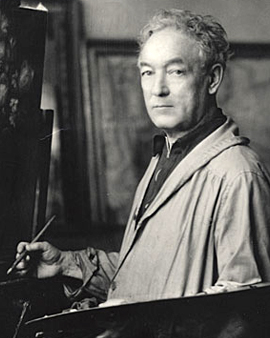


William James Glackens is a famous representative of realism. He lived between 1870 and 1938 and is also co-founder of the Ashcan School in New York, a group of American Realism painters.
In his early artistic years, Glackens worked as an illustrator for the Philadelphia Press and the Philadelphia Record, a daily newspaper. In the evenings he devoted himself to his studies and attended the Pennsylvania Academy of the Fine Arts. There he met John French Sloan and Robert Henri, with whom he founded the Ashcan School. From 1895 Glackens stayed in Europe and visited various art centers. The first station was Holland, where he studied the old masters. He then went to Paris, where he rented a studio and spent a year practicing the Impressionist and Post-Impressionist styles. A further stay in Paris followed in 1912 with the aim of acquiring works of modern European painting, including works by Pablo Picasso, Paul Cézanne and Pierre-Auguste Renoir. Some of the paintings still form the foundation of the Barnes Foundation in Philadelphia today. After his return to Philadelphia, Glackens devoted himself to landscape painting, whereby his early landscape depictions were significantly influenced by James Abbott McNeill Whistler.
Following a stay in Cuba in 1898, he began to paint scenes of big cities. During his New York years, he mainly painted depictions of big cities, taking his cue from impressionists such as Édouard Manet. Here his works also became increasingly brighter and more colorful. He also worked as an artist for the New York World, the New York Herald and as an illustrator for various magazines such as McClure's Magazine. He married Edith Dimmock, a daughter of a wealthy family from Connecticut, and lived with her in Greenwich Village, the epicenter of the New York art scene. In 1906 he became an associate member of the National Academy of Design, where he began teaching as an academic in 1933.

William James Glackens is a famous representative of realism. He lived between 1870 and 1938 and is also co-founder of the Ashcan School in New York, a group of American Realism painters.
In his early artistic years, Glackens worked as an illustrator for the Philadelphia Press and the Philadelphia Record, a daily newspaper. In the evenings he devoted himself to his studies and attended the Pennsylvania Academy of the Fine Arts. There he met John French Sloan and Robert Henri, with whom he founded the Ashcan School. From 1895 Glackens stayed in Europe and visited various art centers. The first station was Holland, where he studied the old masters. He then went to Paris, where he rented a studio and spent a year practicing the Impressionist and Post-Impressionist styles. A further stay in Paris followed in 1912 with the aim of acquiring works of modern European painting, including works by Pablo Picasso, Paul Cézanne and Pierre-Auguste Renoir. Some of the paintings still form the foundation of the Barnes Foundation in Philadelphia today. After his return to Philadelphia, Glackens devoted himself to landscape painting, whereby his early landscape depictions were significantly influenced by James Abbott McNeill Whistler.
Following a stay in Cuba in 1898, he began to paint scenes of big cities. During his New York years, he mainly painted depictions of big cities, taking his cue from impressionists such as Édouard Manet. Here his works also became increasingly brighter and more colorful. He also worked as an artist for the New York World, the New York Herald and as an illustrator for various magazines such as McClure's Magazine. He married Edith Dimmock, a daughter of a wealthy family from Connecticut, and lived with her in Greenwich Village, the epicenter of the New York art scene. In 1906 he became an associate member of the National Academy of Design, where he began teaching as an academic in 1933.
Page 1 / 3






